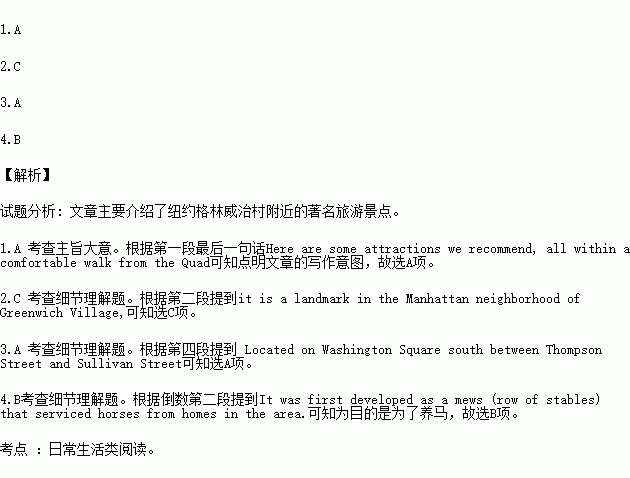题目内容
In addition to seeing wonderful films, one of the joys of coming to the Quad Cinema is to hang out in the area. The Quad is located right in the heart of Greenwich Village, perhaps the most charming and interesting neighborhood in the city. Here are some attractions we recommend, all within a comfortable walk from the Quad:
Washington Square
As one of the best-known of New York City’s 1,900 public parks, it is a landmark in the Manhattan neighborhood of Greenwich Village, as well as a meeting place and center for cultural activity. Come on a Sunday when it’s most lively and festive.
New York University
It surrounds Washington Square. See the impressive Bobst Library and visit the amazing bookstore. NYU is now considered one of the most powerful universities in the world.
Judson Memorial Church
Located on Washington Square south between Thompson Street and Sullivan Street, opposite Washington Square Park, this beautiful church was completed in 1892. The Judson is most famous for its vocal participation in social events.
Washington Mews
It is a hidden, private street in New York City between Fifth Avenue and University Place just north of Washington Square Park. It was first developed as a mews (row of stables) that serviced horses from homes in the area. Since the 1950s the former stables have served as housing, offices and other facilities for New York University.
Jefferson Market Courthouse
Built in 1833 as a market, it was later changed to a courthouse, and in the 1950s it was emptied and close to being destroyed. It was saved and turned into a library. Many consider it to be the most beautiful building in the village.
1.What does the author want to tell in the passage?
A. To introduce some attractions in the Quad.
B. To suggest the Quad Cinema is the best place.
C. To imply the Quad attracts a lot of visitors.
D. To tell readers to enjoy their life fully.
2.The author mentions Washington Square because_______.
A. it is in the center of Greenwich Village
B. it has a history of more than 100 years
C. it is a landmark in the Manhattan
D. it has witnessed so many incidents
3.Where is Judson Memorial Church?
A. To the south of Washington Square.
B. Behind Washington Square Park.
C. Opposite Thompson Street.
D. Close to New York University.
4.When Washington Mews came into being______ .
A. it was designed for a university
B. it was intended for keeping horses
C. it was filled with free facilities
D. it was used as a park for horses
 天天向上一本好卷系列答案
天天向上一本好卷系列答案 小学生10分钟应用题系列答案
小学生10分钟应用题系列答案
